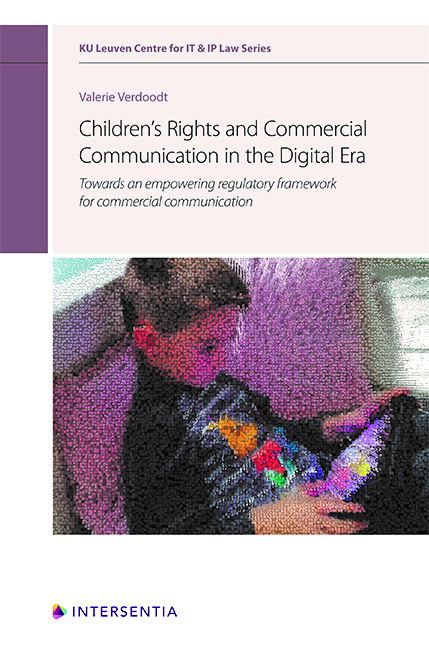 Children's Rights and Commercial Communication in the Digital Era
Children's Rights and Commercial Communication in the Digital Era Book contents
- Frontmatter
- Preface
- Contents
- Abbreviations
- Introduction
- PART I CHILDREN'S RIGHTS AND ADVERTISING LITERACY IN THE DIGITAL ERA
- PART II ASSESSMENT OF THE REGULATORY FRAMEWORK FOR COMMERCIAL COMMUNICATION IN LIGHT OF CHILDREN'S RIGHTS
- PART III ASSESSMENT OF NATIONAL ARIS IN THE AREA OF COMMERCIAL COMMUNICATION
- CONCLUDING REMARKS AND RECOMMENDATIONS FOR THE FUTURE
- Bibliography
- Miscellaneous Endmatter
Chapter II - Evaluation of the Current Regulatory Framework
Published online by Cambridge University Press: 23 July 2020
- Frontmatter
- Preface
- Contents
- Abbreviations
- Introduction
- PART I CHILDREN'S RIGHTS AND ADVERTISING LITERACY IN THE DIGITAL ERA
- PART II ASSESSMENT OF THE REGULATORY FRAMEWORK FOR COMMERCIAL COMMUNICATION IN LIGHT OF CHILDREN'S RIGHTS
- PART III ASSESSMENT OF NATIONAL ARIS IN THE AREA OF COMMERCIAL COMMUNICATION
- CONCLUDING REMARKS AND RECOMMENDATIONS FOR THE FUTURE
- Bibliography
- Miscellaneous Endmatter
Summary
OVERVIEW. After the presentation and clarification of the issues related to children and new forms of commercial communication and a detailed analysis of the role of children's rights in regulating such forms in the first part of the study, the first chapter of this second part provided a descriptive-analytical overview of the legal elements contained in the existing regulatory framework for commercial communication at the EU level. From these previous chapters, an important research question follows: how do new advertising formats and their specific features – i.e. integration, interaction, personalisation and emotional appeal – fit within the identified regulatory framework, while keeping in mind children's rights and principles? In short, this chapter aims to discover any gaps or overlaps and highlight what legal elements are needed to attain a future-proof regulatory framework for commercial communication.
SELECTION OF ADVERTISING FORMATS. The evaluation consists of three use cases, which were selected on the basis of two factors: (1) popularity and (2) the level of risk it poses to children's advertising literacy. The popularity of the formats was extracted from studies on children's and adolescent's media use and the forms of commercial communication that are employed the most in these media. The second factor was extracted from a risk assessment, to determine which of these advertising formats were perceived as highly risky for children and youngsters. As a result, the following (both popular and risky) advertising formats were selected: (1) advergames, (2) personalised advertising and (3) digital influencers and vlogging advertising. These formats also reflect one or more of the features described in the first chapter of the first part of this book (i.e. ‘emerging trends in the area of commercial communication’). Each section will first conceptualise the specific advertising format, the persuasive tactics employed and the impact thereof on children's advertising literacy. Reference is made to the children's rights and principles that were analysed in the second chapter of the first part of the book. Second, the regulatory framework that is applicable to the specific use case or advertising format is evaluated, in light of these rights and principles. More specifically, the evaluation consists of two steps: (1) evaluating whether the existing rules are applicable to the selected advertising format and (2) evaluating whether there are any gaps or overlaps that would hinder the effective realisation of children's rights and principles.
- Type
- Chapter
- Information
- Children's Rights and Commercial Communication in the Digital EraTowards an Empowering Regulatory Framework for Commercial Communication, pp. 183 - 232Publisher: IntersentiaPrint publication year: 2020


